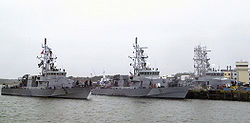- Cyclone class coastal patrol ship
-
Career (US) 
Builder: Bollinger Shipyards General characteristics Displacement: 331 tons (336 metric tons) full load Length: 179 ft (55 m) Beam: 25 ft (7.6 m) Propulsion: Four Paxman diesels; four shafts; 3,350 shaft horsepower (2.50 MW) Speed: 35 knots (40 mph; 65 km/h) Endurance: 2000-2500nm (@12knots, with transit fuel reserve) Crew: Four officers, 24 enlisted personnel Armament: 2 × MK 38 25 mm autocannon
5 × .50 caliber machine guns
2 × MK 19 40 mm automatic grenade launchers
2 × M240B machine guns
6 × FIM-92 Stinger SAMs USS Hurricane (PC-3) moves past USS Whirlwind (PC-11) and an unidentified Cyclone-class patrol ship at Naval Amphibious Base Little Creek, 2005.
USS Hurricane (PC-3) moves past USS Whirlwind (PC-11) and an unidentified Cyclone-class patrol ship at Naval Amphibious Base Little Creek, 2005.
The Cyclone class patrol ships are a class of United States Navy coastal patrol boats. Most of these ships were launched between 1992 and 1994.
The primary mission of these ships is coastal patrol and interdiction surveillance, an important aspect of littoral operations outlined in the Navy's strategy, "Forward...From the Sea." These ships also provide full mission support for Navy SEALs and other special operations forces. The Cyclone class ships are assigned to Naval Special Warfare. Of the thirteen ships, nine originally operated out of the Naval Amphibious Base Little Creek, Norfolk, Virginia, and four originally operated from the Naval Amphibious Base Coronado. These ships provide the Naval Special Warfare Command with a fast, reliable platform that can respond to emergent requirements in a low intensity conflict environment.
Three hulls have been decommissioned and loaned to the United States Coast Guard to be returned to the Navy in 2011 and one was transferred to the Philippine Navy. Of the remaining ten, five are homeported at Little Creek and five are homeported in Bahrain as part of a rotating forward deployment.
The hulls on loan to the US Coast Guard are used in a variety of roles, including search and rescue, interception, boarding, and inspection of foreign freighters arriving at US ports.
In September 2010, the decision was made to recall all of the remaining ships of the class due to fatigue damage to their hulls. The class was designed for a lifespan of roughly 15 years. All but the newest member of the class, Tornado, have been in service longer. The vessels will be inspected and a decision will be made whether to refit them or to decommission the ships.
Contents
Ships
Ship Hull No. Commissioned–
DecommissionedHomeport Status NVR Page Cyclone PC-1 1993–2000 — Transferred to the U.S. Coast Guard in February 2000 as USCGC Cyclone (WPC-1), transferred to the Philippine Navy in March 2004. Now BRP Mariano Alvarez (PS-38). PC-1 Tempest PC-2 1993– Little Creek, VA Active PC-2 Hurricane PC-3 1993– Little Creek Active PC-3 Monsoon PC-4 1994– Little Creek Active PC-4 Typhoon PC-5 1994– Manama, Bahrain Active PC-5 Sirocco PC-6 1994– Manama, Bahrain Active PC-6 Squall PC-7 1994– Little Creek Active PC-7 Zephyr PC-8 1994–2004 Pascagoula, Mississippi On loan to the U.S. Coast Guard as USCGC Zephyr (WPC-8) PC-8 Chinook PC-9 1995– Manama, Bahrain Active PC-9 Firebolt PC-10 1995– Manama, Bahrain Active PC-10 Whirlwind PC-11 1995– Manama, Bahrain Active PC-11 Thunderbolt PC-12 1995– Little Creek Active PC-12 Shamal PC-13 1996–2004 Pascagoula, Mississippi On loan to the U.S. Coast Guard as USCGC Shamal (WPC-13) PC-13 Tornado PC-14 2000–2004 Pascagoula, Mississippi On loan to the U.S. Coast Guard as USCGC Tornado (WPC-14) PC-14 Users
References
This article includes information collected from the Naval Vessel Register, which, as a U.S. government publication, is in the public domain.
External links
- US Navy Fact Sheet
- PC-1 Cyclone class Patrol Coastal Craft (globalsecurity.org)
- WPC-179 Cyclone Patrol Coastal Craft (globalsecurity.org)
- Program Executive Office, Ships - PC
- FAS.org
- Navy Times article on repairs to the class.
Cyclone-class patrol ship Categories:- Patrol vessels of the United States Navy
- Cyclone class coastal patrol ships
- Active patrol vessels of the United States
- United States Navy stubs
- United States naval ship stubs
Wikimedia Foundation. 2010.

